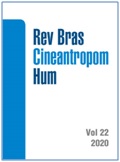Analysis of sex-related differences in external load demands on beach handball
Resumen
The purpose of the present study was to analyze the sex-related differences in beach handball workload. A total sample of 105 handballers (male, n=50; female, n=55) belonging to six U’16 teams, seven U’18 teams and eight senior teams were monitored in the final round of 2018-2019 beach handball tournament celebrated during 3-days congested-fixture design. The external load variables Steps, Jumps, Player Load, Total Impacts (>2G) and Total Impacts per Intensities (very low, 2-4G; low, 4-6G; moderate, 6-8G; high, 8-10G; very high, >10G) through WIMUTM inertial devices. Statistical analysis was composed by t-test and Cohen’s d for anthropometrical variables and by MANOVA and omega partial square for sex and categories related differences. Greater values in male handballers were found in height, weight and age in each categories (U’16: p<0.05; d=0.50-2.26; U’18: p<0.05; d=0.95-2.21; senior: p<0.05; d=1.01-1.99), except in age in U’18 (p=0.97; d=0.01). Respect to external workload, differences were found related to category (p<0.01; ?p²= 0.02-0.05, small) and sex (p<0.01; ?p²= 0.04-0.21, small to high), except in Steps (p=0.47; ?p²= 0.00), finding the greatest sex-related differences in U’16 category. From the differences found in anthropometrical characteristics and external workload, their evaluation during competition allows designing specific training sessions with the purpose of sports performance enhancement in beach handball.
Citas
Sena JEA, Gomes ALM, Mimbacas A, Ferreira UMG. Dermatoglifia, somatotipo e composição corporal no beach handball: Estudo comparativo entre diferentes níveis de qualificação esportiva. Motricidade. 2012;8(S2):567–76.
International Handball Federation. History of beach handball. Basel, Switzerland: International Handball Federation; 2010.
Achenbach L, Loose O, Laver L, Zeman F, Nerlich M, Angele P, et al. Beach handball is safer than indoor team handball: injury rates during the 2017 European Beach Handball Championships. Knee Surg Sports Traumatol Arthrosc. 2018;26(7):1909–15.
Real Federación Española de Balonmano. Reglas de Juego - Balonmano Playa. 1a Edición. Madrid, España: Real Federación Española de Balonmano; 2014. 127 p.
Morillo-Baro JP, Reigal RE, Hernandez-Mendo A. Analysis of positional attack in beach handball male and female with polar coordinates. RICYDE Rev Int Cienc Deporte. 2015;11(41):226–44.
Gruić I, Vuleta D, Bazzeo M, Ohnjec K. Situational efficiency of teams in female part of tournement in the World Beach Handball Championship in Cadiz. 6th International Scientific Conference on Kinesiology, Croatia; 2011. p. 524–8.
Navarro A, Morillo JP, Reigal RE, Hernández-Mendo A. Polar coordinate analysis in the study of positional attacks in beach handball. Int J Perform Anal Sport. 2018;18(1):151–67.
Pueo B, Jimenez-Olmedo JM, Penichet-Tomas A, Becerra MO, Agullo JJE. Analysis of Time-Motion and Heart Rate in Elite Male and Female Beach Handball. J Sport Sci Med. 2017;16:450–8.
Belka J, Hulka K, Safar M, Weisser R, Samcova A. Analyses of time-motion and heart rate in elite female players (u19) during competitive handball matches. Kinesiology. 2014;46(1):33–43.
Lara-Cobos D. La respuesta cardiaca durante la competición de balonmano playa femenino. Apunts Med Esport. 2011;46(171):131–6.
Bartlett JD, O’Connor F, Pitchford N, Torres-Ronda L, Robertson SJ. Relationships Between Internal and External Training Load in Team-Sport Athletes: Evidence for an Individualized Approach. Int J Sports Physiol Perform. 2017;12(2):230–4.
Achten J, Jeukendrup AE. Heart rate monitoring. Sports Med. 2003;33(7):517–538.
Descargas
Publicado
Número
Sección
Licencia

Direitos Autorais para artigos publicados nesta revista são do autor, com direitos de primeira publicação para a revista. Em virtude da aparecerem nesta revista de acesso público, os artigos são de uso gratuito, com atribuições próprias, em aplicações educacionais e não-comerciais, desde que seja dada a atribuição. Esta obra foi licenciada com uma Licença Creative Commons Atribuição 4.0 Internacional - CC BY


